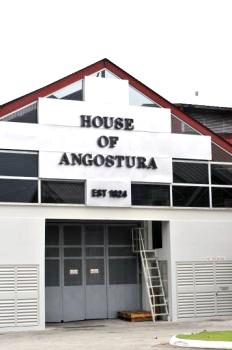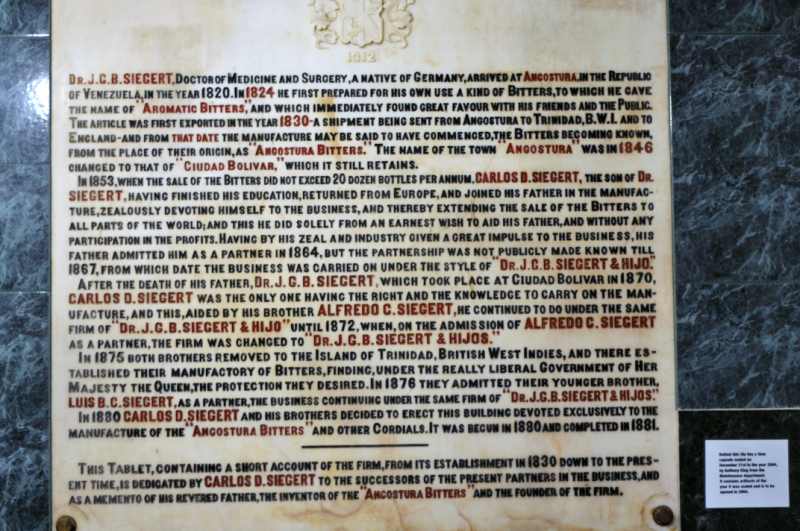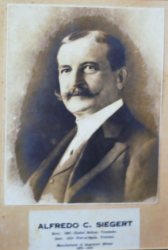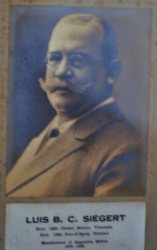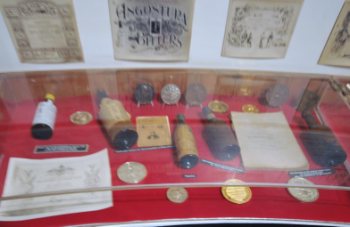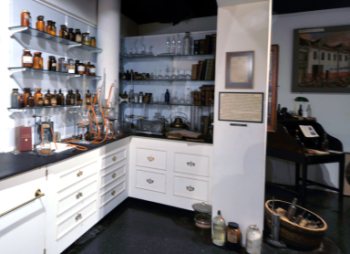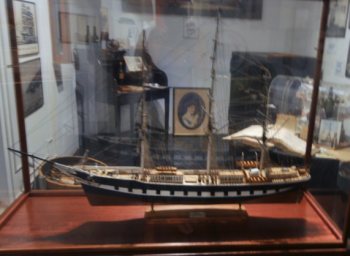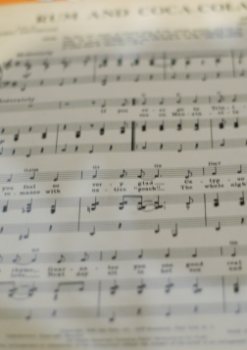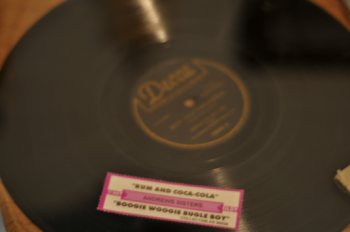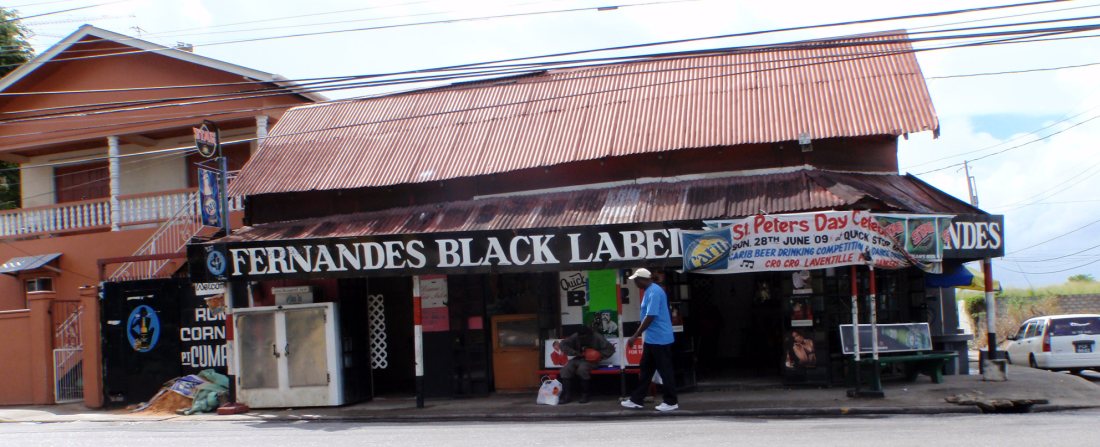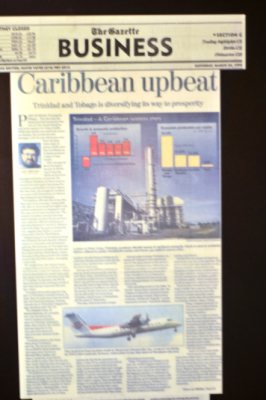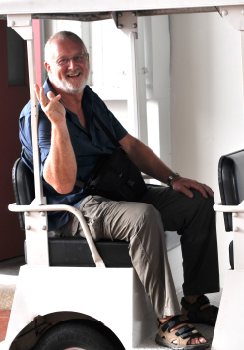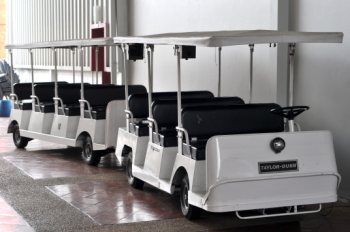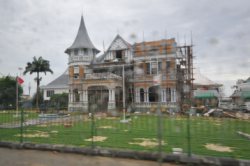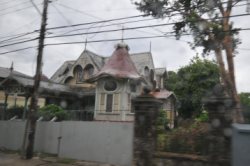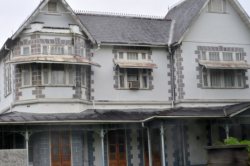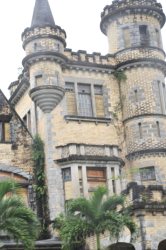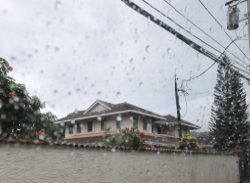|
Visit to The House of
Angostura
After our talk from Tony and being shown how to
hand make the steel pan it was off to The House of
Angostura. Before our tour began at one o'clock we ate lunch in the
companies very smart canteen. We had a choice of fish or chicken served with
rice, pasta, baked beans, salad, hot dressing and salad dressing. Cake for
pudding and we could help ourselves to a juice called Mauby - made from boiled
bark that tasted of aniseed (we can buy this as a cordial in supermarkets, but
we think not) or tropical fruit punch. When we had finished Michele sat us in
the media room and we watched a brief video about the company. It was very
informative but was made in the nineties and could really do with being re-made.
Then it was time to learn all about Doctor J. G. B.
Siegert founder of Angostura bitters.
The House of Angostura (also known as Angostura
Limited) is a Trinidad and Tobago company famous for
the production of angostura bitters, invented by the
company's founder. The company is also a distiller and is the major producer of
rum in T + T. The company also has been used as a vehicle for international
expansion by its parent company, CL Financial. As a result of
these acquisitions, the company owns distillers in the US, Canada, The Bahamas
and Surinam.
Around 1820 Dr Siegert tried to find a
medicine to improve appetite and digestive well-being of the soldiers,
he experimented with many different herbs and spices to come up with the recipe
still used to treat upset stomach, diarrhoea, fevers and hangover. Also pleasing
to drink in a cordial.
The company was founded around 1830 in Ciudad
Bolivar by the German Doctor, Johann Gottlieb Benjamin Siegert,
(born in 1796, died in 1870) he was Surgeon-General in Simon
Bolivar's Army in Venezuela.
| “ |
From the beginning Dr. Siegert was determined to wrest a
cure from nature itself, and after four years of trial and
error, researching and analysing the qualities of
tropical herbs and plants, he finally arrived at a unique blend of herbs
which he called “Amargo Aromatico” or aromatic bitters. [...] Dr. Siegert
hoped to use the bitters to bring relief to his patients, his small circle
of family and friends, but these events were to prove otherwise. From
these humble beginnings an international industry was soon to
rise.
"
The informative
plaque in the museum. The small plaque to the right is actually a
tile behind which a time capsule was sealed on the 21st of December 2004
by Anthony King from the Maintenance Department. It contains artifacts of
the year it was sealed and is to be opened in 3004.
Dr Siegert's three sons Carlos, Alfredo and Luis. He also had three daughters
are not featured here as the era dictated, that they were nothing
other than homemakers. |
|
The word "Angostura" literally
means "Narrows" is the founding name of Ciudad Bolívar - Bolivar City along
the narrows of Venezuela's Orinoco River where Dr. Siegert was based. It was an
important trading town with river access to the sea. In 1830, Dr. Siegert
exported his unique aromatic bitters to England and Trinidad. By 1850, he had
resigned his commission in the Venezuelan army to concentrate on the manufacture
of his bitters, since by then demand had leapt ahead of supply. In 1862 the
product was exhibited and sampled in London, to great approval. Upon his passing in 1870, Dr. Siegert left the care
of the company to his younger brother and son, who subsequently moved it to Port
of Spain, Trinidad six years later in
1876, due to the political unrest at that time in Venezuela.
Over the course of time, Angostura Bitters and
Dr. Siegert's company alone became purveyor to the King of Prussia, Spain, and King George V. Today, angostura bitters are also
produced by various other vendors, some of which add the bark of the angostura tree (Angostura
trifoliata). Angostura bitters are a key ingredient
in many cocktails, for example in pink gin. Angostura brand bitters do not contain
any angostura bark. There are several other companies that make bitters
containing this bark, notably Fee Brothers and Riemerschmid. 1949 Trinidad
Distillery wholly owned by Angostura. 1997 Bacardi sold to Siegert Finance. Bulk
export based in Chaguaramas.
Today as in all the history of the company five
people know the recipe of the bitters. The various herbs and spices are washed,
graded and bagged with a code number in England and travel without any checks
from Customs and Immigration on leaving AND arriving here in Trinidad. Something
we think is quite unique and all due to a deal made many years ago to ensure the
ingredients are never disclosed. When a batch is to be made, one of the five
unknowns, disappears into an attic room, weighs and measures the "botanicals"
and they are shot as a whole down a tube into a waiting vat. The mix is crushed
and the "marriage of flavours begins in the percolators where alcohol is used to
bring out the flavours, sugar and others flavours added and the final result at
44.7% Alc. Vol. is ready for bottling. Angostura Bitters is exported to one
hundred and forty countries world wide.
Displays of the many awards won by Angostura Bitters, examples of the many "pretenders" trying to replicate the recipe.
One corner looks like an apothecary, Angostura has it's own dedicated
team of scientists producing yeasts in-house. Information about
the sailing vessel Doktor Siegert, built in 1875 and
sank in 1895.
Bear examining the
displays. History of the companies cooperage
and a display showing all the local streets named
after family members of the Siegert's.
The Calypso "Rum and Coca Cola" was written,
composed and sung by Calypsonian Rupert Westmore Grant, the Lord Invader, in
1943. In September 1943, the American comedian Morey Amsterdam visited Trinidad
where he heard the Calypso and on his return to New York, he promoted the song
and by the end of 1944, the highly popular Andrews Sisters recorded the song.
Their version was an instant hit. Alerted to these facts for the first time in
January 1945, Lord Invader went to New York in February to
pursue his claim on the lyrics.
His plagiarism claim kept Lord Invader in New
York for three years. In February 1947 Lord Invaders case for the plagiarism of
"Rum and Coca Cola" was sustained. He received a favourable decision when the
case was appealed in December of that year, yet the defendants refused to pay
him until seven years later.
In 1955, Lord Invader finally received one
hundred and thirty two thousand US dollars. An awful lot of money then. The
funny thing to us is that the Andrew Sisters and the fans had no idea what
the song meant. Michele sang a couple of verses for us:
If you ever go
down Trinidad
They make you feel so very glad
Calypso sing and make up
rhyme
Guarantee you one real good fine time
Drinkin' rum and
Coca-Cola
Go down Point Koomahnah
Both mother and daughter
Workin' for
the Yankee dollar
Oh, beat it man, beat it
Since the Yankee come
to Trinidad
They got the young girls all goin' mad
Young girls say they
treat 'em nice
Make Trinidad like paradise
Rum and Coca Cola is
actually about the American Airmen based exactly where we are today, going into
town, drinking Rum and Coca Cola, then paying for the
"services" of the local women and their daughters. The reference to Point
Koomahnah has a famous bar where this all
occurred.
Meanwhile back on the tour. Various clippings show company expansions and successes. A
beautiful Art Deco wall light I fell in love with and
one of the many advertising examples
One House two distinct Families. This is a display featuring
the acquisition in 1979 of Fernadez in the portrait -
who gave every local lad a bottle of rum when they went off to fight in the
Second World War.
It was not raining when we had finished in the
museum so Michele at the helm, took us on a train
ride around the factory stopping to see where the molasses are
delivered (no sugar cane is grown on the island as the Government say it is
cheaper to import. The last processing factory made many thousands unemployed,
they are still waiting for compensation). We went past the workshop that hand
paints the Limbo Drummer bottles, got off the train and had a tour of the
bottling plant - no photography allowed, just like when we visited Mount Gay in
Barbados. Here they bottle twenty two million bottles of rum per year and a
total of three million cases

We drove past the plaque
unveiled by Queen Elizabeth II in 1985 - (she is making a trip to
Trinidad, in a few weeks time, on November the 26th) - to commemorate the
factory extension.
Then it was back to the canteen for some serious
tasting. Michele and our bartender. My favourite new
find was Mokatika a 30.8 % Alc. Vol. coffee liqueur, mixed with evaporated milk
and a couple of dashes of Angostura Bitters and ice. I preferred it when a good
gleggy of rum was added (I don't even begin to think about the calories).
Then time to visit the shop for future 'few further tastings on Beez'. The
company offer a generous discount for staff, I had asked a few during the visit
if people stay with the company for many years and the resounding answer "Yes".
A final look at one of the many paintings around the
building featuring local artists - this one by Boscoe Holder painted in
1995.

After Jessie dragged us out of The House of
Angostura, he took us to the view point over the city for photographs, sadly the
heavens opened and we got back on the bus to look at the old colonial and famous
houses of the Port of Spain.
The last photo is a typical example of where the
'well-heeled' of the city live - aka Millionaires Row.
ALL IN ALL A BRILLIANT
TOUR
|

